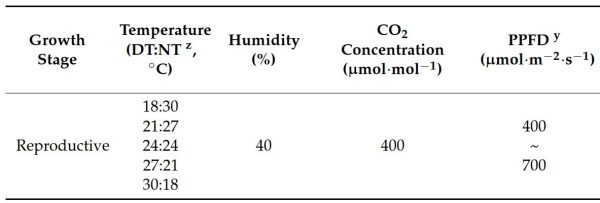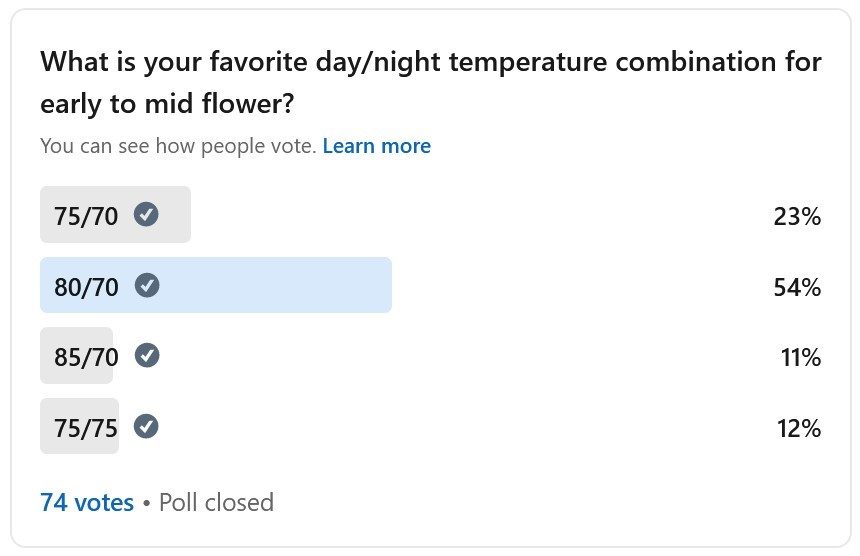Ask any cannabis farmer what their favorite temperature is and they’ll very quickly shoot back a small range of daytime temperatures… but what about the night?
Most growers know there are very specific daytime temperature ranges, but I’ve never heard anybody talk about the idea that night temperature is equally important, and it has a very specific sweet spot, and if you deviate outside that range, you risk lowering pretty much everything that makes cannabis valuable – little things like:
- Flowering rate
- Bud structure
- Bud mass
- Cannabinoid production
If such specific day and night temperature choices are that important, why is nobody talking about this?
And I have to wonder, how many of us might be getting this wrong.
After doing a bit of digging, I found there are quite a few studies that show the importance of using specific day/night temperatures (called DIF) to control the height in all sorts of ornamental plants, but I could find only one that actually studied cannabis.
This study from Korea looked at how different combinations of day/night temperatures affect cannabis.
Cool day – hot night (18:30°C) (65/86F) Negative DIF
Warm day – hot night (21:27°C) (70/81F) Negative DIF
Same day:night temp (24:24°C) (75/75F) No DIF
Warm day – cool night (27:21°C) (81/70F) Positive DIF
Hot day – cold night (30:18°C) (86/64F) Positive DIF
“Plants exhibit various physiological responses to both daily average temperatures and the difference between daytime and nighttime temperatures (DIF). In general, negative DIF conditions (warm night, cool day) are reported to suppress shoot growth in various plant species. The objective of this study was to determine the optimal DIF for enhancing the growth, yield, and chemical composition of medical cannabis cultivated in an indoor farming system.”
Negative DIF
Plants grown with cool days and warm nights (18 day, 30 night) experience a phenomenon of yellowing that the researchers theorize to be caused by reduced production of chlorophyll in the day, and an increased degradation of chlorophyll at night. Both of those processes are temperature driven, so in a normal day you would get more chlorophyll produced in the day than what is degraded at night, but if you invert the day/night temperatures, it shifts the balance and results in more chlorophyll being degraded at night than what is being created in the day, and if this condition persists, the plants gradually become chlorotic.
The 18:30 plant (on the left below) that was exposed to a cool day/hot night conditions became chlorotic and produced very little flower material, and very little cannabinoids.
The plant exposed to 21:27, moderate day/hot night produced a really tall plant which had the highest QUANTITY of flowers and the highest QUANTITY of leaves, but the flowers were so small as to be commercially useless. If there was a market for an ornamental cannabis tree, this would be the recipe to make it!


Neutral DIF
The 24:24 (75F day, 75F night) light ratio is the first one that starts to produce some good looking flowers. However they do appear to be a bit on the fluffy side, and in the graphs below you’ll see how the numbers are not as good as the Positive DIF plants.
Positive DIF
The 27:21 ratio (81F day, 70F night) produced a healthy plant with large solid buds. This temperature combination was the clear winner in bud shape, bud density, total yield, and cannabinoid production.
The 30:18 (86F day, 64F night) group represents the more extreme end of what might be considered indoor growing conditions. This combination produced decent bud shape, density, total yield, and cannabinoid production, but still a bit less than the 27:21 ratio.
Influence on Biomass and Cannabinoids
The graph below shows the differences in plant matter (black) and Flower matter in the white boxes.
Here again, the combination of 27/21°C (81F day, 70F night) wins out and not by a small amount.

Influence on cannabinoid production
The changes to bud structure and size were very obvious in the pictures and the graph above, but it is the change in cannabinoids that really creates the clear winner in the ratio of 27:21°C (81F day, 70F night).

According to this information, the night temperature
is equally as important as the daytime temperature.
This study does reveal some useful information about cannabis growth, but it also creates some new questions for the next study to answer.
The things I don’t like about this study:

- Humidity was held at 40% for all groups with no mention of whether this is actual Humidity, or RH. This is a mistake because Leaf VPD is a combination of temperature and RH. If you fix the RH or the Humidity, then you change the temperatures for each group, you end up with a Leaf VPD that is extremely different for each group. They could have picked a target Leaf VPD of 1.2 as the standard, then set the temperature for each group, and then adjust the RH to get the Leaf VPD of 1.2. That would have created much more similarity in growth conditions between groups.
- CO2 was allowed to stay at ambient levels instead of adding supplemental CO2. This choice could have failed to reveal the potential performance of each group – especially the 30:18 high temperature group which may have performed significantly better with higher CO2.
- They used a PPFD of only 400-700 which is hardly applicable to commercial cannabis. Perhaps this number works because all groups were treated the same, but it is also entirely possible that the two positive DIF groups could have performed far better if conditions were maximized, which may have further increased the spread between the Negative and Positive DIF groups – who knows.
How many growth characteristics are influenced by DIF
Cannabis is considered a short-day or long-night plant because it initiates flowering when it receives a certain length of continuous darkness. In this review [2] of studies performed on other short day plants (not cannabis) that are grown for other commercial values such as height and flower quantity, we find evidence that DIF influences the following characteristics of growth and morphology:
The difference (DIF) between day temperature (DT) and night temperature (NT) influences internode length, plant height, leaf orientation, shoot orientation, chlorophyll content, lateral branching and petiole and flower stalk elongation. Internode length increases as DIF beomes more positive. The response of stem elongation to DIF is greater when DIF increases from zero to positive, than from negative to zero DIF.
DIF has the greatest effect on plant height during the period of rapid growth. Furthermore, the responses to DIF are rapid, and most plants respond to a change in DT and NT within 24 h.
The effect of negative DIF on flowering is different in the short- day plant poinsettia, where negative DIF delayed flowering significantly. The rate of flowering is determined in large part, but not wholly, by night temperature. As the night temperature increased above 2O°C, both flower initiation and flower development were delayed, and at a night temperature of 29°C the plants failed to flower.
DIF interacts with light quality, light intensity, photoperiod and growth retardants, but not with water stress. A physiological explanation for the effects of DIF suggests that DIF may elicit responses through affecting the concentration of endogenous gibberellins (GAS).
Can you use cool temps to make cannabis plants shorter?
According to this study, the temperature combinations seem to have had less of an effect on height than what might be achieved on other plant species. Perhaps that could be because other studies on ornamental plants used much colder temperatures that those used here. From the pictures of the plants used in this study, you can see that a short plant was not created, and in fact the one plant that was treated with the 21:27, moderate day/hot night treatment, actually grew taller than the others.
Plant height could possibly be reduced with extremely cool combinations, but if used in the flower cycle, this could sacrifice the characteristics that make cannabis valuable such as flower mass and total cannabinoids.
Should you use cool temps to make cannabis plants shorter?
According to the data gathered in this study, the sweet spot of 81F in the day and 70F at night was able to significantly outproduce all warmer and colder temperature combinations in measurement of:
- All cannabinoids except CBGA
- Flower biomass
- Flower structure
In the study they wrote, “Plants exhibit various physiological responses to both daily average temperatures and the difference between daytime and nighttime temperatures (DIF).”
By writing the Day/Night “difference” as Day:Night which implies, by the use of a colon, that the ratio of the temperatures is what is important. I would have to disagree with this concept. Based on other studies [3] that have determined daytime temperatures for optimal cannabis photosynthesis to be between 75F and 86F (depending on the geographic area of origin for each cultivar), I believe the reality may be that there is simply a very specific day temperature and a very specific night temperature, which just so happens to coincide with the natural outdoor temperatures that are so common in the temperate zones where cannabis grows best – imagine that – cannabis performs best in the summer temperatures Mother Nature provides.
Here are the results of a two week survey I ran on Linkedin with 74 growers responding…

References:
[1] Optimizing Indoor Hemp Cultivation Efficiency through Differential Day–Night Temperature Treatment https://doi.org/10.3390/agronomy13102636
[2] Effect of diurnal temperature alternations on plant morphology in some greenhouse crops-a mini review doi:10.1016/0304-4238(95)00783-p
[3] Photosynthetic response of Cannabis sativa L. to variations in photosynthetic photon flux densities, temperature and CO2 conditions
doi: 10.1007/s12298-008-0027-x.